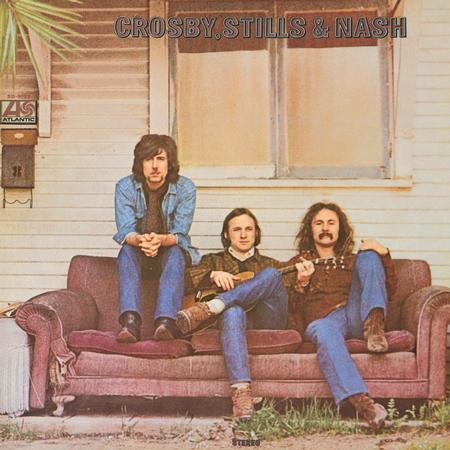"Crosby, Stills & Nash" is a Sonic Tabula Rasa
but this edition by far sounds best
Let's go directly to the sound because to wring something new from the music, especially to this audience, is a time waster. Play a half-dozen editions of Crosby, Stills & Nash and you'll hear six wildly different sonic presentations. Which is "correct"? There's no "artists intent" on this one, there are just different takes depending upon who's doing the mastering and pressing—and even then there are wild variations. Discogs lists 267 versions, worldwide, multiple formats.
I compared this double 45rpm Atlantic 75th anniversary pressing to an original Atlantic -B Rob Grenell cut Presswell pressing, a later Atlantic -F Monarch pressing, an original "plum label" U.K. original, the Classic Records 33 1/3 BG pressing and the recent Electric Recording Company pressing. I did not have the 2022 Mobile Fidelity "One Step" DSD sourced 45rpm pressing but I heard from a few trusted readers and will get one to borrow and follow up. I also didn't have the Nautilus 1/2 speed edition.
Whew! First off, the U.K. Polydor pressed "plum label" Atlantic has Stephen Stills' bass summed so it appears centered on the stage. That's not right! Otherwise it sounds ok, but somewhat dynamically compressed.
On the -B OG, Grenell didn't sum the bass, but he super attenuated it and accentuated the very top. It's not a particularly attractive sounding OG. Someone years ago sent me the -F and he was correct! I think George Piros mastered it. This one has Stephen Stills' bass really popping as I think it should. The rest is pretty good, if just a big bright on top, but no wonder this pressing with a non-textured jacket is preferable to the original!
Let me move forward to the ERC cut using the original master tape. It's a "flat cut". ERC's game plan is to give its customers "documentation" of the tape without equalization or compression of any kind (other than on its Way Out West to apply the Roy DuNann inverse curve). This approach works really well for classical releases and most jazz, but less so for rock. But ERC's customers want the doc and the doc is what they get!
And what the ERC proves is that when left alone, the tape is not all that great. There's more bottom end than on the Grenell cut but not nearly as much as on the -F cut or any of the others. The all tube cut does deliver luxurious midrange and vocal verisimilitude without short changing the steel string strumming.
This new Atlantic 75th anniversary release is from metal parts produced from Bernie Grundman's "back in the day" Classic Records masterings, for which as is usually the case, he cut both 33 1/3 and 45rpm parts. Classic did release a double 45 limited edition release in its twilight years, but I never got one, probably because I figured the double 45 would not sound all that different from the 33 1/3. That was a wrong assumption.
The comparison between the 33 1/3 Classic Records release and this double 45 is pretty shocking. The 33 1/3 Classic is somewhat hard sounding overall because the bass isn't all that prominent. I was surprised and glad I got the 45rpm edition because had I not, I'd have extrapolated from the 33 1/3, which would have been wrong. I'll never do that again!
Given the room to "stretch out", Bernie delivers a bass bomb similar to the -F pressing but even better: cleaner articulation and control, better textures and greater extension. If it sounds "blobby" or out of control, it's your set up, not the cut. The bass is stunning as is the rest. What's supposed to be bright—heavy guitar strumming for instance—is, but the vocals whether massed together center channel on "Suite: Judy Blue Eyes" or nicely separated elsewhere have rich midrange textures and fine detail.
The soundstage is enormous, percussive transients are very well-articulated and honestly, this is by far the best rendering of this recording that I've yet heard and by a very wide margin. If you love it, love David Crosby's voice, love the blend of the three, love those purple berries as much as Chuck Berry, and melt every time from the "Helplessly Hoping" harmonies, you'll be glad you bought this.
I've not heard great things about the One-Step compared to this, but I have to listen for myself because there probably are listeners with turntables incapable of handling the bottom end energy this cut produces and will report it's "muddy sounding". It isn't. If you're on the fence about dropping $60 for this and you love it, best to hop off!












































.png)








